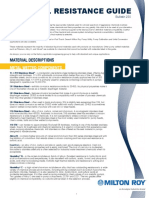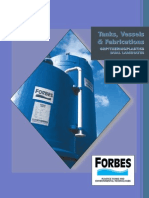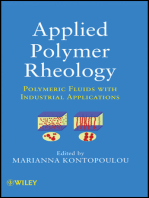Material Selection
Material Selection
Uploaded by
JEDSADAPORN SOPHONCopyright:
Available Formats
Material Selection
Material Selection
Uploaded by
JEDSADAPORN SOPHONCopyright
Available Formats
Share this document
Did you find this document useful?
Is this content inappropriate?
Copyright:
Available Formats
Material Selection
Material Selection
Uploaded by
JEDSADAPORN SOPHONCopyright:
Available Formats
MATERIAL SELECTION
Although there are many published guidelines to material selection, it is important to
remember that whether they are referring to metals or plastics the ratings given tend to
be based on coupon testing under laboratory conditions. They generally do not
differentiate between static and dynamic conditions. Pumps are very different from
tanks faced with zero velocity, or piping which may experience flow velocities in single
digit feet per second. Centrifugal pumps not only face velocities from 50 to 150 feet per
second, but they are exposed to turbulence as well. When considering this combination
of high velocity and turbulence, the corrosive-erosive attack becomes most significant.
This is particularly important when the selection involves a choice between stainless
steel and thermoplastics.
Even when both materials adequately meet the required chemical resistance at the
indicated temperature range, the superior abrasion resistance of thermoplastics makes
them the obvious choice. High velocity in conjunction with turbulence removes the
protective oxide from the chromium/nickel alloys and can lead to premature pump
failure. ( See following table for comparative abrasion resistance).
Another significant material design criterion which should be considered is the suitability
of metal pumps with nonmetallic linings. These are offered as an economical solution to
providing the chemical inertness and abrasion resistance of plastics with the structural
support of an inexpensive metal not requiring corrosion resistance. There are many
applications for which this compromise proves feasible, but the user should be aware of
the potential problems inherent with lined construction.
The following problem potential for lined pumps which were presented at a technical
meeting in Canada some time ago, are as meaningful today as they were then:
• Pin holes or permeability which result in chemical attack on the metal base,
• Lining damage due to solids in the pumpage,
• Thermal cycling or cavitation,
• Liner damage during maintenance.
Evaluation of Material for Nonmetallic pumps – Henry Lee, TRW Mission Mfg.
Canadian Chemical Show: 1976
MATERIALS OF CONSTRUCTION
(A) Thermoplastic Materials
PVC (Polyvinyl Chloride)
Widely used in chemical processing, electroplating, chilled water distribution, deionized
water lines, chemical drainage, and irrigation systems. High physical properties and
resistance to corrosion and chemical attack by acids, alkalies, salt solutions and many
other chemicals. Maximum service temperature is 140ºF.
Vanton Pump & Equipment Corp. 1 May 15, 2004
CPVC (Chlorinated Polyvinyl Chloride)
Its chemical resistance is similar to, but slightly better than PVC. It offers greater
strength. Excellent for hot corrosive liquids where elevated temperatures are involved.
Maximum service temperature is 225ºF.
PP (Polypropylene)
A polyolefin which is lightweight and high in chemical resistance. Chemically resistant to
organic solvents, as well as acids and alkalies. Recommended for general purpose use in
water and waste treatment, laboratories and corrosive plant effluents involving mixed or
unknown chemicals. Maximum service temperature is 180ºF.
PE – (Polyethylene)
This high-molecular weight material is impermeable to water and generally resistant to
organic solvents, acids and alkalies. It is among the lightest of the thermoplastics and
retains good physical properties even at low temperature. Polyethylene is attacked by
strong oxidizing acids and chlorinated or aromatic solvents. Maximum recommended
service temperature is 200ºF.
Fluoropolymer
The three major fluoroplastics widely used in pumps for structural parts are:
polytetrafluoroethylene (PTFE), polyvinylidene fluoride (PVDF), and ethylene
chlorotrifluoroethylene (ECTFE). Each offers particular attractions.
PTFE is perhaps the most inert compound known so it can be exposed to an extremely
broad range of fluids. Its maximum service temperature, 500ºF, is significantly higher
than that of the other two.
PVDF is stronger, stiffer and less subject to creep than PTFE. It retains strength well
throughout its service-temperature range. Its maximum recommended service
temperature is 300ºF. It is chemically resistant to most acids, alkalies (except sodium
hydroxide) and organic solvents and is equally suited for handling wet or dry chlorine,
bromine and the other halogens.
PVDF (Polyvinylidene Fluoride)
Strong, tough and abrasion resistant fluorocarbon material. Chemically resistant
to most acids, bases and organic solvents and equally suited for handling wet or
dry chlorine, bromine and other halogens. Recommended for ultrapure water
applications. Maximum service temperature is 275ºF.
ECTFE has high tensile strength and impact resistance. It is inert to a broad range of
acids, including the oxidizing types. It also can handle alkalies, organic solvents (and
combinations of them), most other corrosive liquids, and abrasive mixtures, even when
used as a coating over metals. Maximum service temperature is 300ºF.
Vanton Pump & Equipment Corp. 2 May 15, 2004
All three of these fluoropolymers are suitable for applications requiring extreme purity
and freedom from contamination. Examples include electronics manufacture and the
handling of ultrapure water.
(B) Elastomeric Components
Thermoplastic pumps require elastomeric materials as well. These are primarily used
where corrosion resistance and impact resistance must be combined with flexibility, as
in gaskets, O-rings and other flexible parts.
Natural Rubber
It offers good resistance to weak and strong acids and alkalies, as well as to oxygenated
solvents. It stands up well against abrasion and has good low-temperature
characteristics. But it is attacked by oxidizing acids and tends to swell in vegetable,
mineral and animal oils.
Butyl Rubber
Formed by the polymerization of butylene and butadiene, this synthetic elastomer has
good resistance to corrosive chemicals in general, including outstanding resistance to
dilute mineral acids. It also resists vegetable and mineral oils. It stands up very well
under heat and offers low gas permeation. It is not recommended for use with petroleum
solvents or aromatic hydrocarbons.
Buna-N (Nitrile Rubber)
This copolymer of butadiene and acrylonitrile has good resistance to weak and strong
acids, as well as alkalies, and is highly inert to aliphatic hydrocarbons, petroleum, and
mineral and vegetable oils. It has excellent water-swell resistance, and its mechanical
properties actually improve at higher temperatures. Buna-N is not recommended for use
with highly polar solvents, such as acetone, methyl ethyl ketone, and chlorinated
hydrocarbons.
Neoprene
It offers excellent resistance to dilute acids and weak and strong alkalies, and good
resistance to petroleum, oils and concentrated acids. It is not recommended for strong
oxidizing acids, esters, ketones or chlorinated aromatic hydrocarbons.
Ethylene-propylene-diene Monomer (EPDM) Rubber
This synthetic elastomer affords excellent low- and high-temperature characteristics. It
resists attack by a wide range of acids and alkalies, detergents, phosphates, ketones,
alcohols and glycols. EPDM does not tend to absorb fluid, nor to swell. It is not
recommended for use with aromatic hydrocarbons.
Vanton Pump & Equipment Corp. 3 May 15, 2004
Chlorosulfonated Polyethylene
It offers good resistance to dilute and concentrated acids and alkaline solutions,
regardless of their pH. Resistance to strong oxidizing acids is excellent.
Other Elastomers
Copolymers of vinylidene fluoride and hexafluoropro-pylene have excellent resistance to
oils, fuels, lubricants and most mineral acids and stand up against many aliphatic and
aromatic hydrocarbons that attack other rubbers. They are not recommended for low-
molecular-weight esters or ethers, nor for ketones or certain amines, nor hot anhydrous
hydrofluoric acid or chlorosulfonic acids.
Copolymers of perfluoromethyl vinyl ester and tetrafluoroethylene offer virtually
unmatched resistance to all classes of chemicals, except fluorinated solvents. Continued
use at temperatures to 550ºF is possible, and intermittent use to 600ºF. The material
neither creeps nor flows, and it becomes more elastic rather than embrittled with heat
aging. The major disadvantage is extremely high cost.
In addition to the structural thermoplastics and the elastomers, thermoplastic pump
manufacturers sometime employ ceramics in seal components. Two of the most common
are a ceramic-graphite composite with a silicon-carbide surface that stands up well
against abrasion and heat, and a sintered silicon carbide that offers extremely high
corrosion resistance to aggressive liquids and solutions, such as bromine.
ASSURING QUALITY AND RELIABILITY
The engineer should insist that the supplier test every pump before shipment, rather
than relying on random sampling. Testing should in all cases include output flowrate,
head pressure, and energy input. Centrifugal pumps should also be hydrostatically
checked for leaks up to the rated seal pressure. Hydraulic Institute (Cleveland, Ohio)
guidelines should be followed for all testing.
Routine vibration testing can be carried out by sound and touch, but the findings should
be checked with a vibration meter if they appear to be borderline. Shaft straightness
and run out should be examined, and run out of the impellers and similar circular parts
should be assessed by an indicator on a motorized fixture.
Be sure to specify that the pump impellers be dynamically balanced. Forestalling shaft
vibrations not only makes for accurate flowrates and long seal life but also can help the
pump meet workplace-noise limitations, such as those of the U.S. Occupational Safety
and Health Administration. Pump buyers’ concerns about erosion stemming from surface
grinding or hold drilling required for balancing are unwarranted.
Vanton Pump & Equipment Corp. 4 May 15, 2004
Table (1)
PROPERTIES OF RIGID PUMP MATERIALS
Hardness Abrasion Impact
Max.Temp Specific Tensile R = Rockwell Resistance (IZOD)
Material Gravity Strength D = Shore Weight C = Charpy
ºF ºC (psi) B = Barcol Loss (mg)
Br = Brinell Taber, 1000
cycles
PVC 140 60 1.30 6,000 – 7,500 R 113 12 – 20 1.4 – 2.0
CPVC 210 99 1.49 7,500 – 11,000 R 121 20 0.6
PE 200 93 0.92 – 0.94 3,500 – 5,600 R 35 – 40 5 1.5 – 12.20
PP 185 85 0.94 4,000 – 5,000 R 80 – 110 15 – 20 0.5 – 2.2
PVDF 275 135 1.75 5,500 – 8,250 D 80 5 – 10 3.6 – 4.0
No break at
ECTFE 300 149 1.75 6,500 – 7,500 D 75; R 93 5 – 10 73ºF
PTFE 500 260 2.14 – 2.20 2,000 – 5,000 D 50 – 55 500 – 1,000 3.0
FRP/GRP 250 121 3.4 – 5.0 10,000 – 13,000 B 35 – 40 388 – 520 --
S/S N/A N/A 7.9 65,000 – 77,000 Br 130 50 C 70
Table (2)
COMPARATIVE PROPERTIES OF ELASTOMERICS
Material Max.Temp Description
ºF ºC
Natural Rubber Good resistance to acids, caustics attached by oxidizing acids, swells in
220 104 solvents.
Buna-N Resists acids, caustics, aliphatic hydrocarbons and oils.
(Natural Rubber) 250 120 Not suitable for solvents or chlorinated hydrocarbons.
Neoprene Multipurpose, resists sunlight, ozone, caustics and oils, grease
(Synthetic Rubber) 250 120 chemicals, weathering, dilute acids.
Butyl Rubber Resists corrosive chemicals and dilute mineral acids, good for vegetable
(Synthetic Elastomer) and mineral oils, but not for solvents or aromatic hydrocarbons.
250 120
Nordel® General purpose, excellent chemical, ozone and heat resistance,
(Hydrocarbon Rubber) 300 149 suitable for wide range of chemicals, low absorption or swelling.
Viton® Resists heat, corrosion, corrosive chemicals, ozone, oils, and aromatic
(Fluoroelastomer) 400 204 hydrocarbons.
Hypalon® Resists abrasion, oils, oxidizing chemicals, sunlight, weathering, dilute
(Synthetic Rubber) 275 135 and concentrated acids and caustics.
Vanton Pump & Equipment Corp. 5 May 15, 2004
You might also like
- Akzo Nobel Paint Colors ManualDocument1 pageAkzo Nobel Paint Colors ManualShesharam ChouhanNo ratings yet
- DSM Chemical Resistance TablesDocument32 pagesDSM Chemical Resistance TablesJacp2No ratings yet
- How Industrial Businesses Can Reduce Production Costs With Reverse Osmosis: Industrial Reverse OsmosisFrom EverandHow Industrial Businesses Can Reduce Production Costs With Reverse Osmosis: Industrial Reverse OsmosisRating: 5 out of 5 stars5/5 (1)
- Chemical Resistance Guide 6-2015Document8 pagesChemical Resistance Guide 6-2015kbala_murugan2011No ratings yet
- LMI Chemical Resistance GuideDocument8 pagesLMI Chemical Resistance GuideShesharam ChouhanNo ratings yet
- Chemical Resistance Guide For Valves: Val-Matic Valve and Manufacturing CorpDocument13 pagesChemical Resistance Guide For Valves: Val-Matic Valve and Manufacturing CorpEdinsonNo ratings yet
- Chemical Compatibility Table DebemDocument49 pagesChemical Compatibility Table DebemTrung Thật LêNo ratings yet
- (Good) ChemicalResistanceGuide - Many SealsDocument13 pages(Good) ChemicalResistanceGuide - Many SealscrystaltanNo ratings yet
- Plastic Handbook PDFDocument139 pagesPlastic Handbook PDFErika Castillo NievesNo ratings yet
- CORROSION PROTECTION Rubber Lining and Coating SystemsDocument16 pagesCORROSION PROTECTION Rubber Lining and Coating SystemsAnonymous YzSzB0rpNKNo ratings yet
- Valve Chemical ResistanceDocument0 pagesValve Chemical ResistancebbmokshNo ratings yet
- Materials - Viton, Nitrile, Silicone, Polyurethane, EPDM, Fluorosilicone, Teflon, PTFE Filled, PEEK, Nylon, AcetalDocument14 pagesMaterials - Viton, Nitrile, Silicone, Polyurethane, EPDM, Fluorosilicone, Teflon, PTFE Filled, PEEK, Nylon, Acetalpankaj_pawar89No ratings yet
- RLDocument8 pagesRLBalasubramanian AnanthNo ratings yet
- Material Pof ConstructionDocument1 pageMaterial Pof ConstructionNabil RamehNo ratings yet
- Engineering Handbook Harrington PDFDocument116 pagesEngineering Handbook Harrington PDFAdriana HernandezNo ratings yet
- Chemical Resistance Guide For Valves: March 25, 2010Document11 pagesChemical Resistance Guide For Valves: March 25, 2010akramhomriNo ratings yet
- ChemRes PDFDocument71 pagesChemRes PDFCarlos TarquinoNo ratings yet
- Equipment Design HW01Document4 pagesEquipment Design HW01Grin NikiforovNo ratings yet
- PagesDocument139 pagesPagesednoguera87No ratings yet
- AOC Corrosion GuideDocument36 pagesAOC Corrosion Guidetarun.imdrNo ratings yet
- Technological Institute of The Philippines: 363 P. Casal, Quiapo, ManilaDocument6 pagesTechnological Institute of The Philippines: 363 P. Casal, Quiapo, ManilaMichelle MendozaNo ratings yet
- Polyacetal Copolymer POM-C Engineering ThermoplasticsDocument9 pagesPolyacetal Copolymer POM-C Engineering Thermoplasticshudi_leksonoNo ratings yet
- Poly Sulfone SDocument23 pagesPoly Sulfone SSimay CanaşNo ratings yet
- Assignment 2 Mechanical DesignDocument11 pagesAssignment 2 Mechanical DesignSalihin Fhoozi100% (1)
- R HPP Chemical Processing EN PDFDocument36 pagesR HPP Chemical Processing EN PDFKumar SaravanaNo ratings yet
- Material Description: PolyvinylsDocument13 pagesMaterial Description: Polyvinylsyuvaraja.dhanabalNo ratings yet
- High Performance Plastics Materials Guide: Craftech Industries'Document20 pagesHigh Performance Plastics Materials Guide: Craftech Industries'akirloskar100% (1)
- Chemline: Actuation and Actuated ValvesDocument44 pagesChemline: Actuation and Actuated ValvesRohit GadekarNo ratings yet
- Piping Engineer BookDocument107 pagesPiping Engineer BookMiguel Angel GrimaldoNo ratings yet
- Halar Ectfe Pfa Coating VesselsDocument3 pagesHalar Ectfe Pfa Coating VesselsBrijesh GajjarNo ratings yet
- Forbe Tanksvessels MLDocument5 pagesForbe Tanksvessels MLPrashant FayeNo ratings yet
- AOC Corrosion GuideDocument36 pagesAOC Corrosion GuidebiondimiNo ratings yet
- Valve Material Chemical Compatibility Lookup - Flowstar (UK) Limited PDFDocument5 pagesValve Material Chemical Compatibility Lookup - Flowstar (UK) Limited PDFHARSHANo ratings yet
- Peek vs. MetalDocument3 pagesPeek vs. MetalAzizol WahabNo ratings yet
- Chemline Chemical Resistance Guide 2008 CompleteDocument32 pagesChemline Chemical Resistance Guide 2008 Completesheldon1jayNo ratings yet
- GOT Packer Elastomer Guidebook-11Document15 pagesGOT Packer Elastomer Guidebook-11elhachemi.achourNo ratings yet
- Chemline.chemical Resistance Guide.02.21.2023Document36 pagesChemline.chemical Resistance Guide.02.21.2023Matun N PatelNo ratings yet
- 2013-Material_Compatibility_Gasket_Materials_LewandDocument17 pages2013-Material_Compatibility_Gasket_Materials_Lewandusha.chandra1988No ratings yet
- Valves Eat Seal Materials and Service TypesDocument3 pagesValves Eat Seal Materials and Service Typescoolguy12345No ratings yet
- Corrosion GuideDocument32 pagesCorrosion Guidedarsh2001patelNo ratings yet
- Tabla Resistencia Quimica Trim ValvulasDocument14 pagesTabla Resistencia Quimica Trim ValvulasJorge Navas VargasNo ratings yet
- Pro Sense Chem ResistanceDocument10 pagesPro Sense Chem ResistancekiikiiwzevesNo ratings yet
- Erez - eBook Polymer GuideDocument14 pagesErez - eBook Polymer GuidewaqargilllNo ratings yet
- Chemical Resistance GuideDocument36 pagesChemical Resistance GuideHeiner PalaciosNo ratings yet
- Anti-Corrosive Composites For Oil and Gas IndustryDocument7 pagesAnti-Corrosive Composites For Oil and Gas IndustryjimmyhuangcpNo ratings yet
- Pom, Pet, PC, TpuDocument81 pagesPom, Pet, PC, TpuPreksha AgrawalNo ratings yet
- Pipe Selection Guide FRP Piping SystemsDocument2 pagesPipe Selection Guide FRP Piping SystemsOmar Mokhtar100% (1)
- DS10-P(Manual)(En)Document15 pagesDS10-P(Manual)(En)KMC ENGNo ratings yet
- Ion Exchange Resins and Adsorbents in Chemical Processing: Second EditionFrom EverandIon Exchange Resins and Adsorbents in Chemical Processing: Second EditionRating: 5 out of 5 stars5/5 (1)
- Hydrostatic and Hydro-Testing in the Oil and Gas FieldFrom EverandHydrostatic and Hydro-Testing in the Oil and Gas FieldRating: 3 out of 5 stars3/5 (2)
- Clear and Plastic Danger - The Alien in your KitchenFrom EverandClear and Plastic Danger - The Alien in your KitchenRating: 4 out of 5 stars4/5 (1)
- Polyoxymethylene Handbook: Structure, Properties, Applications and their NanocompositesFrom EverandPolyoxymethylene Handbook: Structure, Properties, Applications and their NanocompositesNo ratings yet
- Applied Polymer Rheology: Polymeric Fluids with Industrial ApplicationsFrom EverandApplied Polymer Rheology: Polymeric Fluids with Industrial ApplicationsMarianna KontopoulouNo ratings yet
- Giant Molecules: Essential Materials for Everyday Living and Problem SolvingFrom EverandGiant Molecules: Essential Materials for Everyday Living and Problem SolvingNo ratings yet
- 2020 Kynar PVDF Industrial Membranes Brochure OptimizedDocument8 pages2020 Kynar PVDF Industrial Membranes Brochure OptimizedvolkanNo ratings yet
- Opw Retail Fueling Catalog Print Version 09 2024Document233 pagesOpw Retail Fueling Catalog Print Version 09 2024Flaco SantiagoNo ratings yet
- AIN Plastics Shapes For Machining BrochureDocument4 pagesAIN Plastics Shapes For Machining BrochurelarjcaNo ratings yet
- Material Offshore SelectionDocument80 pagesMaterial Offshore SelectionZaimatul Sulfiza100% (1)
- Enhancement of Dielectric Constant in Polymer-CeramicDocument9 pagesEnhancement of Dielectric Constant in Polymer-CeramicRicardoNo ratings yet
- High-Performance Photocatalytic Membranes For Water PurificationDocument20 pagesHigh-Performance Photocatalytic Membranes For Water PurificationMihaiNo ratings yet
- Influence of Dry Mixing and Distribution of Conductive Additives in Cathodes For Lithium Ion BatteriesDocument9 pagesInfluence of Dry Mixing and Distribution of Conductive Additives in Cathodes For Lithium Ion BatteriesMDRNo ratings yet
- Progress and Challenges For Replacing N Methyl 2 Py 2024 Progress in NaturalDocument13 pagesProgress and Challenges For Replacing N Methyl 2 Py 2024 Progress in Naturalmosab.backkupNo ratings yet
- ConclusionDocument2 pagesConclusionNimalanNo ratings yet
- RS485 Resistive Level SensorsDocument4 pagesRS485 Resistive Level SensorsshadyghanemNo ratings yet
- PVDF CompleteDocument33 pagesPVDF CompleteIbram GunarsaNo ratings yet
- Fluoroplastics PDFDocument192 pagesFluoroplastics PDFramzibtrNo ratings yet
- Literature ReviewDocument36 pagesLiterature Reviewprakush_prakush0% (1)
- SPEC of Pipes For ShipbuildingDocument13 pagesSPEC of Pipes For ShipbuildinggopaltryNo ratings yet
- Ink-Jet Printing of Micro-Electro-Mechanical Systems (MEMS) : MicromachinesDocument19 pagesInk-Jet Printing of Micro-Electro-Mechanical Systems (MEMS) : MicromachinesArunNo ratings yet
- Ebook Powder CoatingDocument280 pagesEbook Powder Coatingpakde jongko100% (37)
- KALAS-Ficha Tecnica HMWPEDocument2 pagesKALAS-Ficha Tecnica HMWPEqaqc443No ratings yet
- JSW Color Coated - 25 7 2020Document16 pagesJSW Color Coated - 25 7 2020Aditya TripathiNo ratings yet
- Formulation Development and Compatibility Study of Dexketoprofen Injection Used in The Management of Post-Operative PainDocument7 pagesFormulation Development and Compatibility Study of Dexketoprofen Injection Used in The Management of Post-Operative PainAdeeva MaulidaNo ratings yet
- Sangir Plastics - Product Catalogue PDFDocument68 pagesSangir Plastics - Product Catalogue PDFAbhay DolasNo ratings yet
- 2467 PHD FinalDocument8 pages2467 PHD Finallinhpic99No ratings yet
- Halar Ectfe: Typical PropertiesDocument8 pagesHalar Ectfe: Typical PropertiesDipesh ParekhNo ratings yet
- Nucleation of the Electroactive γ Phase and Enhancement of the Optical Transparency in Low Filler Content Poly (Vinylidene) Clay NanocompositesDocument7 pagesNucleation of the Electroactive γ Phase and Enhancement of the Optical Transparency in Low Filler Content Poly (Vinylidene) Clay NanocompositesPrapto PraptNo ratings yet
- AG FittingsDocument10 pagesAG FittingseduardoNo ratings yet
- Kynar ExplanationDocument2 pagesKynar Explanations_omeone4usNo ratings yet
- WhitePaper-critical Steps in Selecting Fluid ConnectorsDocument4 pagesWhitePaper-critical Steps in Selecting Fluid ConnectorsJosh LeBlancNo ratings yet
- How To Decide Between Anodizing Painting & PVDF CoatingDocument5 pagesHow To Decide Between Anodizing Painting & PVDF CoatingNaveen Karki100% (1)
- Low Cost Pressure Sensor MatrixDocument4 pagesLow Cost Pressure Sensor MatrixhablulNo ratings yet
























































































